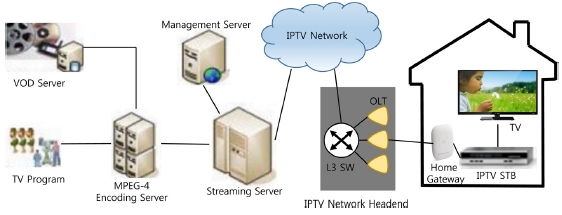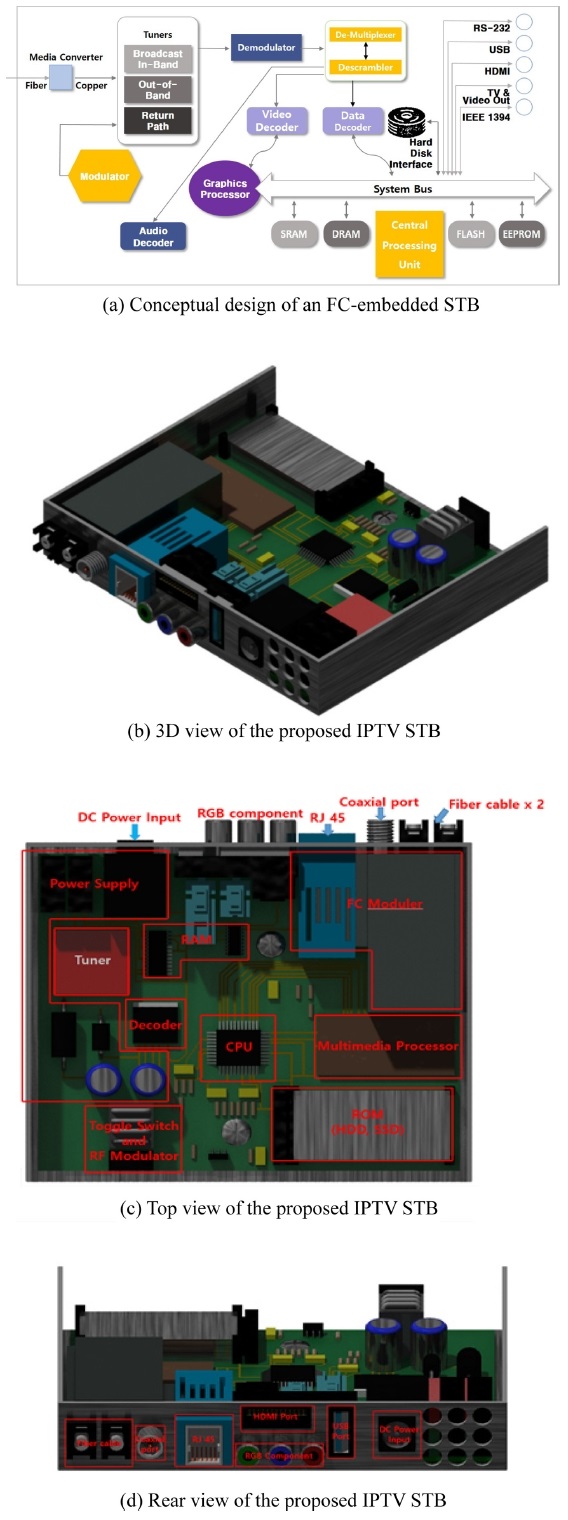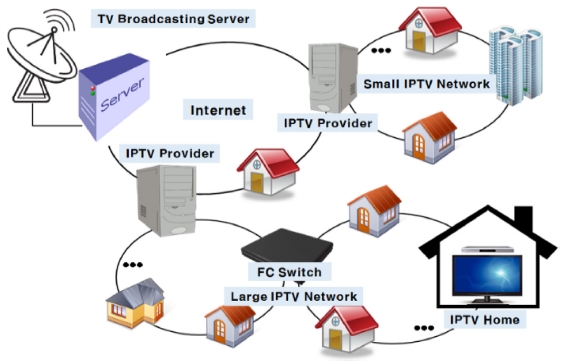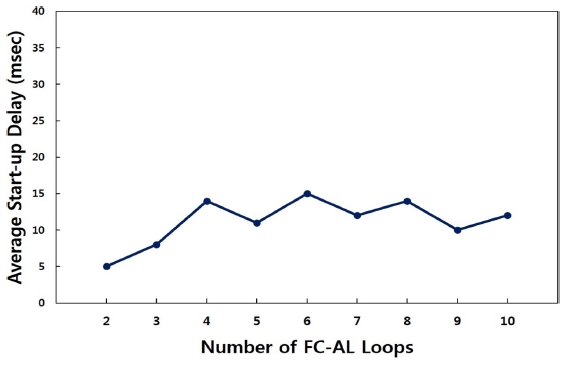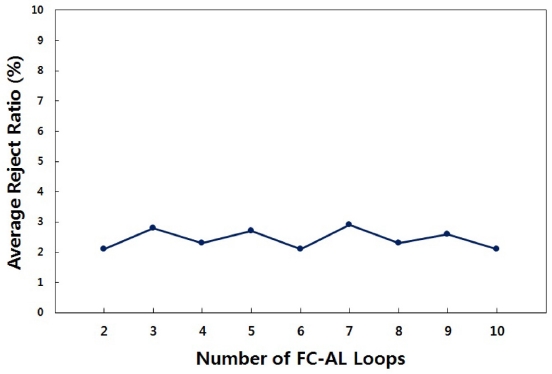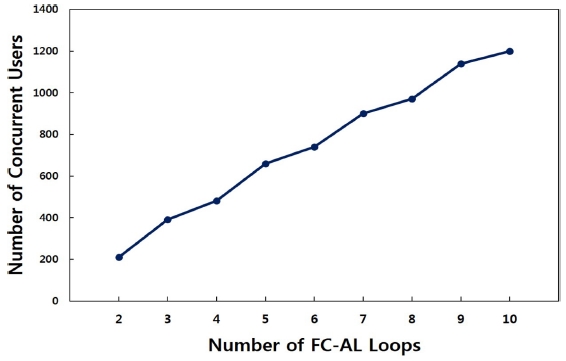
New Design of a Fiber Channel-Embedded Set-Top Box for IPTV Networks
Copyright © The Korean Society for Precision Engineering
This is an Open-Access article distributed under the terms of the Creative Commons Attribution Non-Commercial License (http://creativecommons.org/licenses/by-nc/3.0) which permits unrestricted non-commercial use, distribution, and reproduction in any medium, provided the original work is properly cited.
Abstract
The Internet protocol television (IPTV) service enables people to enjoy various Internet-based services via conventional TV watching. In the IPTV system, a set-top box (STB) is the key since it works as a terminal device that can relay real-time multimedia content from the Internet. However, the current IPTV STB functions as an attached device in a local area network although the actual IPTV network is usually served by an optical fiber-based network such as fiber-to-the-home (FTTH). Therefore, we introduce a novel fiber channel (FC)-embedded IPTV STB to fully use the sufficient optical fiber-based network bandwidth such as 1 Gbps. To verify the IPTV network capabilities by impact of the FC-embedded STB, we evaluate the performance of the FC-embedded STB-attached IPTV network architecture via extensible simulations in terms of an average startup-delay, an average reject ratio, and the number of concurrent users. Surprisingly, the suggested IPTV system demonstrates superior average startup-delay (less than 15 msec), an acceptable average reject-ratio less than 3%, and an almost linear increasing number of concurrent users, which reveals that the FC-embedded STB significantly affects the entire FC-AL-based IPTV network performance by efficiently facilitating the broadband optical fiber bandwidth.
Keywords:
Set-top box Design, Fiber channel-embedded set-top box, Optical fiber network, Internet protocol television키워드:
셋톱박스, 파이버채널내장형 셋톱박스, 광섬유 네트워크, 인터넷프로토콜 텔레비전1. Introduction
With rapid progresses in computer and mechanical technologies including computer networks, computing powers, and manufacturing technologies, realtime content distributions have been very common, especially without considering a specific time and a designated location. That is, people can easily enjoy various contents nowadays, for example, videos on demand (VODs) or live TV programs, though various broadband networks using several devices, such as televisions (TVs), personal computers (PCs), smart-phones, or tablets. In addition, various content-delivering network architectures such as public switched telephone networks (PSTNs), cable networks, or TV broadcasting systems have converged into the Internet protocol (IP)-supported network systems depending on the network technology advances, which means that the type of contents is no longer important in terms of network technologies. Instead, it is much significant how any type of contents can deliver to any devices of users at anytime and anywhere.
These trends have applied to the way of TV-content distribution. That is, TV contents, in general, have broadcast on terrestrial networks or delivered on cable networks. However, as realtime content distributions and IP-based networks have spread, it becomes possible that live TV contents can be viewed on various computer-based devices including PCs, laptops, and smart-phones.
Besides, it is also possible that VOD-content can be delivered to TVs via the IP-based networks since TVs have an IP-supported interface. These tendencies result in network-based telecommunication companies’ expansion into TV-content delivery. Moreover, a present set-top box generally can attach IP-based network and connect to TVs via a coaxial cable, which is a network-enabled computing device with a channel tuner, a streaming decoder, and a hard-disk.1,2 Thus, the telecommunication companies have introduced an IPTV service, which is a realtime TV-content distribution service via an IP-based network. In fact, the IPTV service is a convergent service of TV broadcasting and IP network service where any content is being delivered to each home by streaming in realtime.3-5 The IPTV service has many advantages such as HD-quality TV-content watching, a bi-directional service, VOD-watching on TV, and many Internet-based services including Internet-searching, web-surfing, social network service (SNS) on TV, which is possible since the TV is connected to an IP-based network via a STB.6
In the IPTV service, the STB is key since the STB is an important role instead of a TV. That is, the STB work as a device which is connected to an IP-based network and a terminal which receives any content by streaming in realtime while relaying it to the TV. At the same time, it also serves as a storage device so that it can store the content onto its hard-disk for some reasons like a time-shifting service or another way of content distribution by sharing. In fact, the STB can be considered as a terminal device in terms of a network architecture since it works as a networked device on an IP-based network.
Nevertheless, the conventional STB is mainly regarded as an ordinary device which is just linked to a local network, for example, plugged to the Ethernet with an unshielded twisted pair (UTP) connector. Usually, the IPTV STB is connected to a home network which can be any access network such as PSTN network, cable network, or fiber-to-the-home (FTTH). Although the STB is linked to FTTH with speed of 1 Gbps (Gbits/sec)7,8, it hardly utilizes the full bandwidth due to LAN-sharing with other home devices. Therefore, we propose a novel FC-embedded STB which can fully facilitate the FC bandwidth so that various Internet-based services can be effectively supported including high definition (HD)-quality IPTV contents sharing and distributions, or a home media center service for diverse multimedia devices.
In order to expose the superiority of our proposed FC-embedded IPTV STB, we examine the performances of IPTV networked communities where the suggested FC-compatible STBs are applied via extensible simulations. The simulation results, then, reveals the remarkable performances in terms of a start-up delay, a reject ration, and the number of concurrent users.
This article is organized as follows: Section 2 describes how an FC-enabled STB is devised and designed. In addition, the fiber channel-arbitration loop (FC-AL)-based IPTV network is also explained in the same section. We, then, investigate the performances of the suggested FC-embedded STB-adopted IPTV community with extensive simulations in Section 3. Finally, we conclude the impacts of the proposed novel IPTV STB in Section 4.
2. An FC-Embedded STB and an FC-AL-Based IPTV Network
2.1 Design of an FC-Embedded STB
In general, a typical optical fiber-based FTTH network architecture for high-quality IPTV content delivery is illustrated in Fig. 1. The IPTV contents can be transmitted from the content server to each IPTV home through the FTTH network. In fact, the IPTV headend near IPTV homes links an optical fiber connection to each home and the optical fiber-enabled home gateway converts the signal to IP format so that the Internet-based services can cover the entire home. In case of IPTV, one registered jack (RJ) 45 connector, a typical Ethernet connector, from the home gateway is plugged into the IPTV STB which is directly linked to a TV, as shown in Fig. 1. However, this way of connection is usually for sharing the FTTH bandwidth with other home networked devices, which implies that the IPTV cannot fully facilitate the optical fiber’s reliable and broadband transfer rate, e.g., 1 Gbps. Thus, we, in this article, introduce a novel FC-enabled IPTV STB which includes FC media converter features as well as fundamental IPTV functions.
The proposed FC-embedded IPTV STB is demonstrated in Fig. 2. In specific, Fig. 2(a) shows the functions of IPTV STB, especially containing the media converter. In particular, Figs. 2(b)-2(d) illustrate clear views of the proposed STB, which is actually designed by the 3D EXPERIENCE, the new version of 3ds’ CATIA.9 In fact, the CATIA is a powerful and effective 3D design tool so that we can facilitate it to illustrate our proposed FC-embedded IPTV STB. In fact, the proposed STB is mainly different from the conventional STB in terms of embedded FC media converter in order to fully utilize the broad FC bandwidth, as shown in Fig. 2(c). Furthermore, in order to evaluate actual impacts of the suggested STB, we can apply the devised FC-enabled STB to the IPTV network simulations. As considered in Fig. 2(a), the media converter is included in the suggested STB as the FC modular which converts the optic fiber signal to IP format so that the IPTV STB can fully utilize the entire optic fiber’s broadband bandwidth.
2.2 An FC-AL-Based IPTV Network
Once our proposed FC-embedded STB is adopted in the IPTV network, we then need to consider how to organize the whole IPTV network architecture even when using the FTTH connection. Interestingly, a fiber channel-arbitration loop (FC-AL) is one of the physical media to organize a broadband network architecture, which can offer a gigabit file transfer (e.g. 8Gbit/s in 8GFC, Gigabit Fiber Channel), a full-duplex communication, and a fair arbitration algorithm.10,11 In addition, the FC also supports the FCIP (FC over IP) protocol, the iFCP (Internet Fiber Channel Protocol) protocol and the iSCSI (Internet Small Computer System Interface) protocol by which FC frames can be delivered over IP networks effectively.12,13 Thus, we can apply multiple-loop FC-AL configurations with the proposed FC-embedded STBs for a realtime IPTV network architecture, as shown in Fig. 3.
Once the IPTV network architecture using the FC-embedded STBs is organized, it is also required to evaluate whether or not, the IPTV architecture can serve as a realtime content distribution network in terms of an acceptable start-up delay, a reasonable reject ratio, and many concurrent users with respect to a given condition, while convincing our proposed STB can effective work with fully facilitating the optical fiber’s sufficient broadband bandwidth. Hence, we instigate the effectiveness of the suggested IPTV network architecture using the FC-embedded STBs in the following section.
3. Simulations and Results
To validate the effectiveness of our proposed IPTV architecture with proposed STBs in terms of a realtime content-delivery network, we have performed extensive simulations for 3 categories, i.e., average start-up delay, average reject ratio, and the number of concurrent users, based on the organization of Fig. 3 using FC multiple-loops with the FC switch.
In the simulations, it is assumed that each TV program has HD quality of 19.4 Mbps playback rate and is 60 minute long although ultra HD (UHD) is recently introduced. This is because most of present IPTV systems still adopt mainly HD as well as standard definition (SD) instead of UHD due to the controversy of UHD standardization and frequency use.14 The broadcast programs are also distributed evenly among loops and the probability that each program is requested is uniform so that the amount of data traffic between each pair of loops can be fairly compared. The request rate of program playback follows a Poisson distribution. Each available STB issues requests for different programs every 60 minutes. It is also assumed that 126 STBs are connected to each loop and half of them on average are available at a specific time. Note that the routing between two loops is determined by the number of hops and the tie-breaking is determined randomly. The details of parameters used for disks and FC-AL are also described in Table 1.
3.1 Average Start-Up Delay
We configure our extendible IPTV network architecture from 2 FC-AL loops up to 10 FC-AL loops while adding one loop at a time so that we can analyze the effectiveness of the suggested IPTV architecture with extending the size of the whole architecture. Then, we have measured the average start-up delay of each IPTV architecture. Surprisingly, our suggested architecture demonstrates superior average start-up delays, i.e., less than 15 msec, as illustrated in Fig. 4, even when increasing the number of FC-AL loops, i.e., enlarging the size of the whole architecture, when compared to a typical realtime content-distribution architecture which generally can be regarded as tolerable with 1-sec start-up delay.15 Especially,16 describes that a desirable STB should operate with less than 350 msec in start-up and less than 500 msec in channel change, which exposes our system’s effective star-up delay.
3.2 Average Reject Ratio
We have also analyzed our suggested IPTV platform’s average reject ratios. Similar to the previous section, we have examined our IPTV network performances according to the number of FC-AL loops. In Fig. 5, our system still shows outstanding average-reject ratios, i.e., less than 3% even when almost all users in the whole extendible IPTV architecture are involved in the IPTV viewing. That is, although the typical average reject is around 10% especially in the worst case of all users requests any contents simultaneously as explained in,17 our system outperforms in terms of average reject ration with less than 3%.
3.3 Number of Concurrent Users
As a practical IPTV network architecture, we have evaluated the number of concurrent users according to the number of FC-AL loops. Fig. 6 shows that the trend of the number of concurrent users in our suggested IPTV network is almost linear depending on the number of FC-AL loops, which implies that our extendible IPTV architecture using the FC switch can effectively support the whole traffic of the IPTV network architecture. That is, we can determine that our IPTV system can work as a remarkable realtime content-delivery network even when adding more FC-AL loops.
4. Conclusion
In order to fully utilize the reliable and broadband optical fiber-based network, it is required to devise a novel FC-embedded IPTV STB including the converting module by which the optical signals can be changed to IP-enabled format. The FC-embedded STB is designed by the 3D EXPERIENCE, the new version of CATIA,9 thereby appropriately applying to one of the IPTV network components.
Once the STBs are deployed to an IPTV network, we then need to consider the whole IPTV system performances to see if the impacts of the proposed STB can be effectively reflected. Thus, in order to analyze the effectiveness of the suggested IPTV architecture using the FC-embedded STBs, we have performed extensive simulations with average start-up delay, average reject ratio, and number of concurrent users. Them, we showed a superior start-up delay less than 5 msec, an acceptable average-reject ratio less than 3%, and an effective number of concurrent users with linear increase via thorough simulations. Therefore, we can conclude that our innovative FC-embedded STB significantly affects the entire FC-AL-based IPTV network performances with efficiently facilitating the broadband optical fiber bandwidth by revealing the remarkable network capabilities.
Acknowledgments
This research is financially supported by Changwon National University in 2017-2018.
REFERENCES
-
O'Brien, J., Rodden, T., Rouncefield, M., and Hughes, J., “At Home with the Technology: An Ethnographic Study of a Set-Top-Box Trial,” ACM Transactions on Computer-Human Interaction (TOCHI), Vol. 6, No. 3, pp. 282-308, 1999.
[https://doi.org/10.1145/329693.329698]

-
Edwards, W. K., Newman, M. W., Smith, T. F., Sedivy, J., and Izadi, S., “An Extensible Set-Top Box Platform for Home Media Applications,” IEEE Transactions on Consumer Electronics, Vol. 51, No. 4, pp. 1175-1181, 2005.
[https://doi.org/10.1109/TCE.2005.1561841]

-
Xiao, Y., Du, X., Zhang, J., Hu, F., and Guizani, S., “Internet Protocol Television (IPTV): The Killer Application for the Next-Generation Internet,” IEEE Communications Magazine, Vol. 45, No. 11, pp. 126-134, 2007.
[https://doi.org/10.1109/MCOM.2007.4378332]

-
Simpson, W., “Video Over IP: IPTV, Internet Video, H.264, P2P, Web TV, and Streaming: A Complete Guide to Understanding the Technology,” Taylor & Francis, pp. 333-362, 2013.
[https://doi.org/10.4324/9780080888170]

- Kumari, P. and Rani, P., “A Comprehensive Survey on Internet Protocol Television (IPTV),” International Journal of Engineering and Computer Science, Vol. 4, No. 6, pp. 12391-12394, 2015.
-
Brown, B. and Barkhuus, L., “The Television will be Revolutionized: Effects of PVRs and Filesharing on Television Watching,” Proc. of the SIGCHI Conference on Human Factors in Computing Systems, pp. 663-666, 2006.
[https://doi.org/10.1145/1124772.1124870]

-
Kim, J. H., Kim, S. H., Kang, H. J., Cho, S.-U., Lee, T. H., et al., “Implementation of PLC Device by Roll to Roll Process,” J. Korean Soc. Precis. Eng., Vol. 31, No. 6, pp. 469-475, 2014.
[https://doi.org/10.7736/KSPE.2014.31.6.469]

-
Jung, D., Sohn, I.-B., Noh, Y.-C., Kim, J.-H., Kim, C., et al., “Laser Microfabrication of Multidirectional Side-Fire Optical Fiber Tip,” J. Korean Soc. Precis. Eng., Vol. 30, No. 10, pp. 1017-1022, 2013.
[https://doi.org/10.7736/KSPE.2013.30.10.1017]

- Dassault Systemes, “3DEXPERIENCE,” https://www.3ds.com/products-services/3dexperience/, (Accessed 21 JUL 2017)
-
Kim, E. and Liu, J. C., “An Integrated Network/Storage Architecture for Sharing High-Quality Broadcast TV Contents,” IEEE Communications Magazine, Vol. 43, No. 9, pp. 86-93, 2005.
[https://doi.org/10.1109/MCOM.2005.1509972]

-
Kim, E. and Liu, J. C., “Design of HD-Quality Streaming Networks For Real-Time Content Distribution,” IEEE Transactions on Consumer Electronics, Vol. 52, No. 2, pp. 392-401, 2006.
[https://doi.org/10.1109/TCE.2006.1649655]

- Clark, T., “IP SANs: A Guide to iSCSI, iFCP, and FCIP Protocols for Storage Area Networks,” Addison-Wesley, pp. 236-244, 2002.
-
Telikepalli, R., Drwiega, T., and Yan, J., “Storage Area Network Extension Solutions and their Performance Assessment,” IEEE Communications Magazine, Vol. 42, No. 4, pp. 56-63, 2004.
[https://doi.org/10.1109/MCOM.2004.1284930]

- Kim, G., “The Policy of UHD Broadcasting Systems Using 700 Mhz Frequency,” Hallym ICT Policy Journal, pp. 18-21, 2015.
-
Sitaraman, R. K., “Network Performance: Does it Really Matter to Users and by How Much?” Proc. of the Fifth International Conference on Communication Systems and Networks, pp. 1-10, 2013.
[https://doi.org/10.1109/COMSNETS.2013.6465563]

- Bing, B., “3D and HD Broadband Video Networking,” Artech House, pp. 25-27, 2010.
-
Dakshayini, M. and Nair, T., “Client-to-Client Streaming Scheme for VOD Applications,” International Journal of Multimedia & Its Applications, Vol. 2, No. 2, pp. 46-55, 2010.
[https://doi.org/10.5121/ijma.2010.2204]

